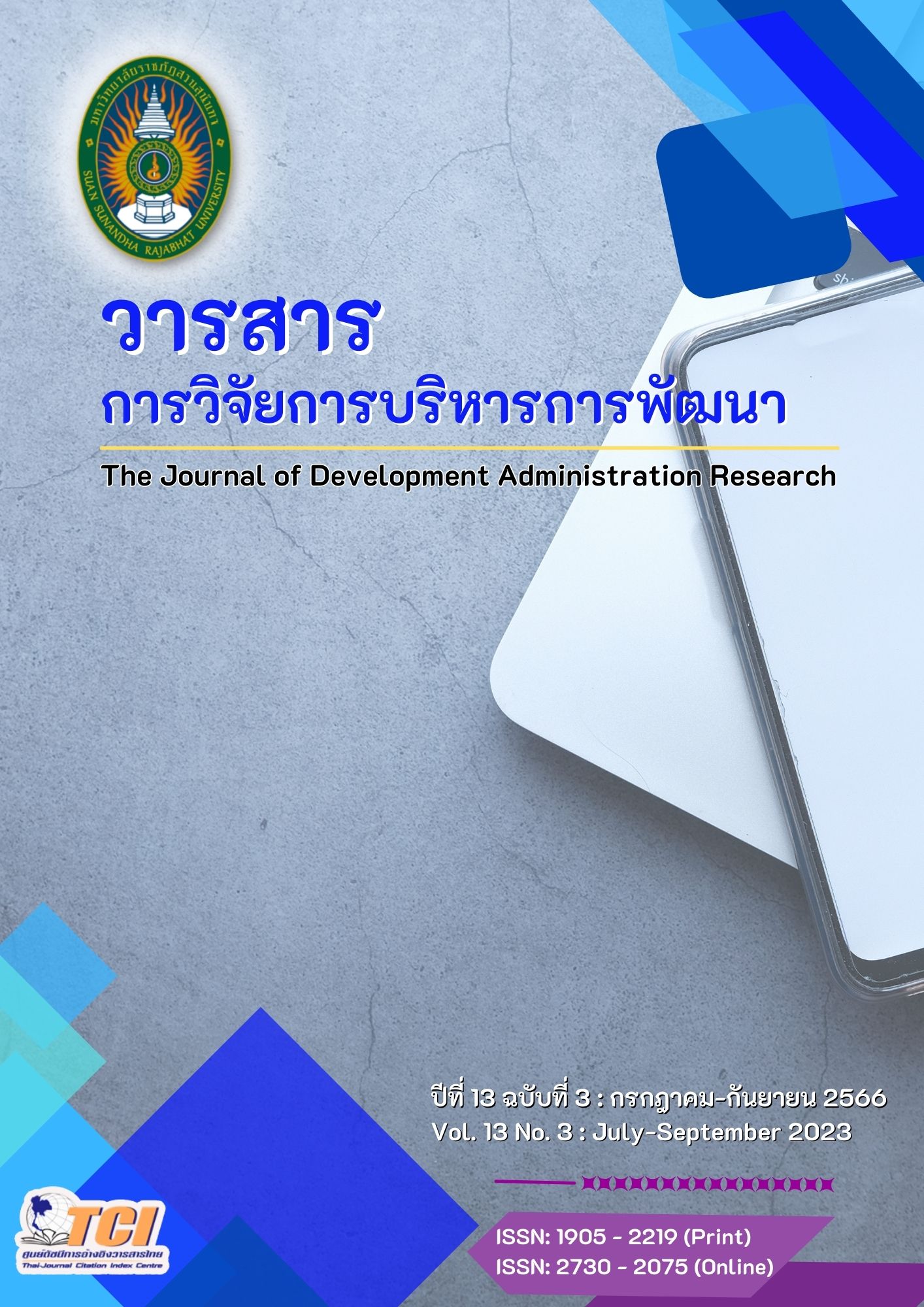ความร่วมมือของภาคีเครือข่ายการศึกษาทางเลือกไทย กรณีศึกษา ภาคีเครือข่ายการศึกษาชนเผ่าพื้นเมือง และ ภาคีเครือข่ายเด็กและเยาวชน
คำสำคัญ:
ความร่วมมือ, เครือข่าย, การศึกษาทางเลือก, นโยบายบทคัดย่อ
บทความวิชาการนี้มีวัตถุประสงค์ 1) เพื่อศึกษาพัฒนาการความร่วมมือของภาคีเครือข่ายการศึกษาทางเลือก 2) เพื่อศึกษาปัจจัยที่นำไปสู่ความร่วมมือของภาคีเครือข่ายการศึกษาทางเลือก 3) เพื่อศึกษากระบวนการความร่วมมือของภาคีเครือข่ายการศึกษาทางเลือก และ 4) เพื่อศึกษาผลผลิต ผลลัพธ์ อุปสรรคของกระบวนการความร่วมมือของภาคีเครือข่ายการศึกษาทางเลือก รูปแบบการวิจัยเป็นการวิจัยเชิงคุณภาพใช้แนวคิดความร่วมมือเป็นกรอบการวิจัย พื้นที่วิจัย คือ เชียงใหม่ เชียงราย และกรุงเทพมหานคร กลุ่มตัวอย่างคือ เครือข่ายการศึกษาชนเผ่าพื้นเมือง และ เครือข่ายเด็กและเยาวชน จำนวน 30 คน ใช้วิธีคัดเลือกแบบเฉพาะเจาะจงการเก็บรวบรวมข้อมูล ดำเนินการโดยการสัมภาษณ์เชิงลึก ข้อค้นพบจากงานวิจัยพบว่า
- พัฒนาการความร่วมมือของภาคีเครือข่าย เริ่มจากผู้คนที่มีอุดมการณ์ทางด้านการศึกษาทางเลือกร่วมกัน
- ปัจจัยที่นำไปสู่ความร่วมมือของภาคีเครือข่าย พบว่า ปัจจัยที่สำคัญที่สุด คือ กฎหมายและนโยบาย
- กระบวนการความร่วมมือของภาคีเครือข่ายการศึกษาทางเลือกไทย พบว่า หัวใจสำคัญที่สุดของกระบวนการความร่วมมือ คือ อุดมการณ์ที่มีร่วมกัน
- ผลผลิตที่เกิดขึ้นจากความร่วมมือของภาคีเครือข่าย คือ การแลกเปลี่ยนเรียนรู้ร่วมกัน ในความร่วมมือกันพบว่า มีอุปสรรคในเรื่องของความหลากหลายของสมาชิก ที่ส่งผลต่อความเข้าใจหรือแนวทางในการดำเนินงาน ทำให้เครือข่ายมีการจัดการพูดคุยกันเพื่อสร้างความเข้าใจซึ่งกันและกันอยู่เสมอ ผลลัพธ์จากความร่วมมือ คือ ความสุขของผู้เรียน
ข้อค้นพบจากงานวิจัยนี้ พว่า ภาครัฐควรเปิดโอกาสในการมีส่วนร่วมจากภาคส่วนต่าง ๆ ในการกำหนดนโยบาย เนื่องจากภาคส่วนต่าง ๆ ของสังคมนั้นมีข้อมูลเพียงพอในการแก้ไขปัญหาและตอบสนองความต้องการอย่างแท้จริง
เอกสารอ้างอิง
วิไลลักษณ์ เยอเบอะ. (2554). เส้นทางสู่การจัดการศึกษาชนเผ่าพื้นเมือง. ค้นเมื่อ 25 พฤษภาคม 2565, จาก https://imnvoices.com/?p=589
สถาบันบัณฑิตพัฒนบริหารศาสตร์. (2525). แนวการศึกษาวิชาการบริหารงานบุคคลในความหมายที่กว้าง.กรุงเทพฯ: สถาบันบัณฑิตพัฒนบริหารศาสตร์.
สมาคมสภาการศึกษาทางเลือกไทย (สกล.). (2563). องค์ความรู้การศึกษาทางเลือกของสังคมไทยกับแนวทางการขับเคลื่อนเพื่อการพัฒนาที่ยั่งยืน (รายงานวิจัย). สำนักงานกองทุนสนับสนุนการวิจัย (สกว.).
สิงหนาท ราชภัณฑารักษ์. (2563). กรอบแนวคิดในการประสานความร่วมมือระหว่างภาครัฐ ภาคเอกชน และภาคีเครือข่ายในการจัดการอุทกภัยขนาดใหญ่. วารสารการจัดการภาครัฐและเอกชน, สถาบันบัณฑิตพัฒนบริหารศาสตร์, 27(2), 101-116.
Abele, J. (2013). Bringing mind together. In H. Ibarra & M. T. Hansen (Eds.), HBR’s 10 must reads on collaboration. Boston: Harvard Business School.
Agranoff, R. (2006). Inside collaborative networks: Ten lessons for public managers. Public Administration Review, 66, 56-65.
Agranoff, R. (2007). Managing within networks: Adding value to public organizations. Washington, DC: Georgetown University Press.
Agranoff, R. & McGuire, M. (2001). Big questions in public network management. Journal of Public Administration Research and Theory, 11(3), 295-326.
Agranoff, R., & McGuire, M. (2003). Collaborative public management: New strategies for local governments. Washington, DC: Georgetown University Press.
Ansell, C., & Gash, A. (2008). Collaborative governance in theory and practice. Journal of Public Administration Research and Theory, 18(4), 543-571.
Bevir, M. (2011). Governance as theory, practice, and dilemma. London: Sage.
Booher, D. E. (2005). Collaborative governance practices and democracy. National Civic Review, 93(4), 32-46.
Bryson, J. M., Crosby, B. C., & Stone, M. M. (2006). The design and implementation of cross-sector collaborations: Propositions from the literature. Public Administration Review, 66(1), 44-55.
Coombs, P. H. (1981). New strategic for improving rued family life. Essex, CT: International Council for Educational Development.
Emerson, K., & Nabatchi, T. (2015). Collaborative governance regimes. Washington,DC: Georgetown University Press.
Emerson, K., Nabatchi, T., & Balogh, S. (2012). An integrative framework for collaborative governance. Journal of Public Administration Research & Theory, 22, 1-29.
Enroth, H. (2011). Policy network theory. London: Sage.
Gray, B. (1989). Collaborating: Finding common ground for multiparty problems. San Francisco: Jossey-Bass.
Heckscher, C., Prusak, L. & Adler, P. (2013). Building a collaborative enterprise. Boston: Harvard Business School.
Ibara, H. & Hansen, M. T. (2013). Are you a collaborative leader?. Boston: Harvard Business School.
Jackson, D. & Maddy, J. W. (2005). Ohio state university fact sheet: Introduction. Retrieved May 18, 2021, from http://ohioline.osu.edu/bc-fact/0001.html
Kast, F. E. & Rosenzweig, J. E. (1972). General systems theory: Applications for organization and management. The Academy of Management Journal, 15(4), 447-465.
Klijn, E. H., & Koppenjan, J. M. F. (2016). Governance networks in the public sector. London: Routledge.
McDermott, R., & Archibald, D. (2013). Harnessing your staff’s informal network. Boston: Harvard Business School.
McGuire, M. (2006). Collaborative public management: Assessing what we know and how we know it. Public Administration Review, 66, 33-43.
Meuleman, L. (2008). Public management and the metagovernance of hierachies, networks and markets: The feasibility of designing and managing governance style combinations. Cham, Switzerland: Springer Nature.
Morse, R. S. (2005, September). Facilitating interlocal collaboration: Community and the soft skills of public management. Working Group on Interlocal Services Cooperation. Paper 15. Retrieved May 18, 2021, from https://digitalcommons.wayne.edu/interlocal_coop/15/
Pisano, G. P., & Verganti, R. (2013). Which kind of collaboration is right for you?. Boston: Harvard Business School.
Sink, D. (1996). Five obstacles to community-based collaboration and some thoughts on overcoming them. London: Sage.
Sullivan, H. & Skelcher, C. (2002). Working across boundaries: Collaboration in public services. New York: Macmilan.
Thomson, A. M. & Perry, J. L. (2006). Collaboration processes: Inside the black box. Public Administration Review, 66(1), 20-32.
Thomson, A.M., Perry, J. L. & Miller, T. K. (2008). Linking collaboration processes and outcomes: Foundations for advancing empirical theory. New York: ME Sharpe.
Torfing, J. (2019). Collaborative innovation in the public sector: The argument. Public Management Review, 21(1), 1-11.
United Nations Educational, Scientific and Cultural Organization (UNESCO). (2020). Global education monitoring report summary 2020 inclusion and education: All means all. Paris: United Nations Educational, Scientific and Cultural Organization.
Vangen, S., & Huxham, C. (2010). Introducing the theory of collaborative advantage. In S. Osborne (Ed.), New public governance: Emerging perspectives on theory and principle of public governance. New York: Routledge.
ดาวน์โหลด
เผยแพร่แล้ว
รูปแบบการอ้างอิง
ฉบับ
ประเภทบทความ
สัญญาอนุญาต
ลิขสิทธิ์ (c) 2023 วารสารการวิจัยการบริหารการพัฒนา

อนุญาตภายใต้เงื่อนไข Creative Commons Attribution-NonCommercial-NoDerivatives 4.0 International License.
บทความที่ได้รับการตีพิมพ์เป็นลิขสิทธิ์ของมหาวิทยาลัยราชภัฏสวนสุนันทา
ข้อความที่ปรากฏในบทความแต่ละเรื่องในวารสารวิชาการเล่มนี้เป็นความคิดเห็นส่วนตัวของผู้เขียนแต่ละท่านไม่เกี่ยวข้องกับมหาวิทยาลัยราชภัฏสวนสุนันทา และคณาจารย์ท่านอื่นๆ ในมหาวิทยาลัยฯ แต่อย่างใด ความรับผิดชอบองค์ประกอบทั้งหมดของบทความแต่ละเรื่องเป็นของผู้เขียนแต่ละท่าน หากมีความผิดพลาดใดๆ ผู้เขียนแต่ละท่านจะรับผิดชอบบทความของตนเองแต่ผู้เดียว




